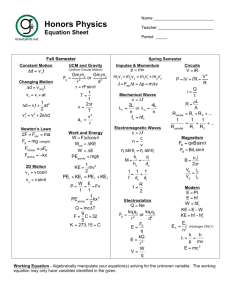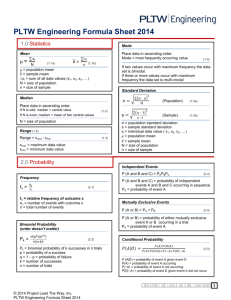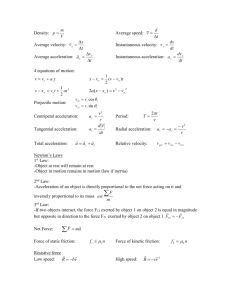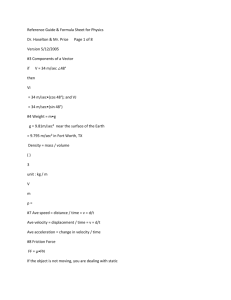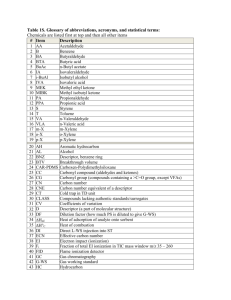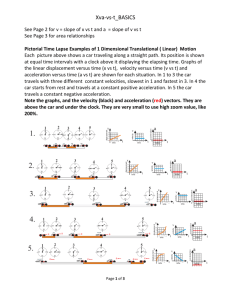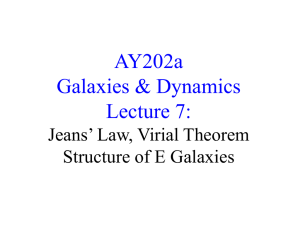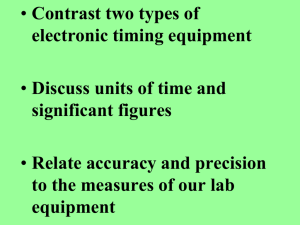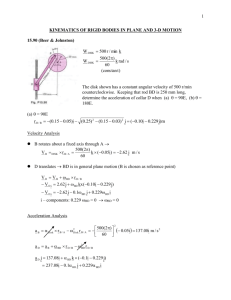STAAR Physics Reference Materials
advertisement
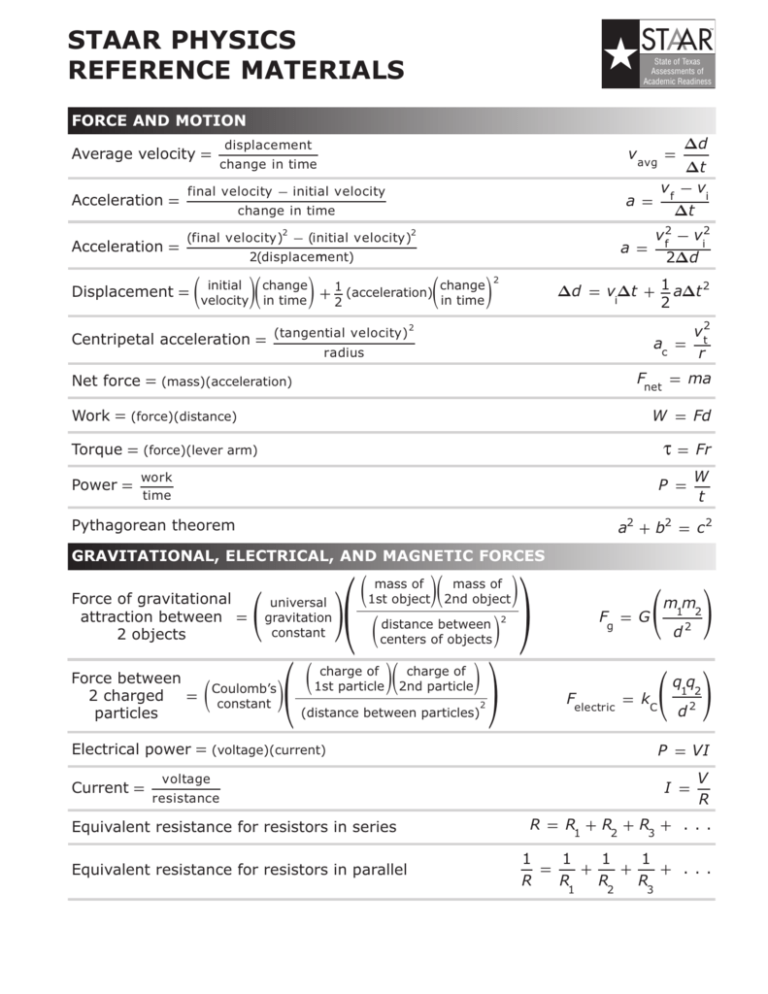
STAAR STAAR PHYSICS RefeRenCe MATeRIAlS TM State of Texas Assessments of Academic Readiness F Average velocity = Acceleration = Acceleration = displacement vavg = change in time final velocity − initial velocity 2 2 (final velocity) − (initial velocity) a = 2(displace ment) ( )( ∆t v f − vi a = change in time ) ( initial change change Displacement = velocity + 1 (acceleration) in time in time 2 ) ∆d ∆t v f2 − vi2 2∆d ∆d = vi∆t + 1 a∆t 2 2 2 v t2 ac = r 2 Centripetal acceleration = (tangential velocity) radius Net force = (mass)(acceleration) Work = (force)(distance) Fnet = ma W = Fd τ Torque = (force)(lever arm) work Power = time Pythagorean theorem = Fr P = W t a2 + b2 = c 2 GRAVITATIOnAl, eleCTRICAl, AnD MAGneTIC fORCeS Force of gravitational attraction between = 2 objects ( universal gravitation constant Force between 2 charged = Coulomb’s constant particles ( ( ( ) )( ( ( mass of 1st object )( mass of 2nd object distance between centers of objects charge of 1st particle )( charge of 2nd particle ) (distance between particles) 2 ) ) 2 ) ) Fg = G ( ) ( ) Felectric = kC m1m2 d2 q1q2 d2 Current = voltage resistance Equivalent resistance for resistors in series Equivalent resistance for resistors in parallel I = V R R = R1 + R2 + R3 + . . . 1 1 1 1 = + + + . . . R R1 R2 R3 STAAR STAAR PHYSICS RefeRenCe MATeRIAlS TM State of Texas Assessments of Academic Readiness ENE 1 Kinetic energy = 2 (mass)(velocity) KE = 1 mv 2 2 2 ( ) acceleration Gravitational potential energy = (mass) due to gravity (height) ( spring Elastic potential energy = 1 2 constant )( distance stretched or compressed ) PEg = mgh 2 PEelastic = 1 kx 2 2 Energy = (power)(time) E = Pt Mechanical energy = kinetic energy + potential energy ME = KE + PE KEi + PEi = KE f + PE f Law of conservation of energy Momentum = (mass)(velocity) p = mv Impulse = (force)(change in time) = (mass)(change in velocity) m1v1 + m2v2 = m1v1 + m2v2 Law of conservation of momentum ( Heat gained or lost = (mass) specific heat J = F ∆t = m∆v i )( change in temperature ) i f f Q = mcp∆T WAVeS AnD lIGHT Velocity = (frequency)(wavelength) 1 Focal length = 1 distance to image Energy = (mass)(speed of light)2 v = fλ + 1 1 distance to object f = 1 di + 1 do E = mc 2 STAAR STAAR PHYSICS Reference Materials TM State of Texas Assessments of Academic Readiness CONSTANTS AND CONVERSIONS m s 8 c = speed of light = 3.00 × 10 m g = acceleration due to gravity = 9.8 s G = universal gravitation constant = 6.67 × 10 k c = Coulomb’s constant = 8.99 × 10 9 m = mass of Earth = 5.97 × 10 24 E 6 newton (N) = kg ⋅ m s 2 joule (J) = N ⋅ m watt (W) = J N⋅m = s s hertz (Hz) = cycle s −11 C kg N⋅m kg N⋅m r = radius of Earth = 6.37 × 10 m E 2 2 2 2 2 7 6 5 4 3 2 1 3 (262) (267) 7 7B Actinide Series Lanthanide Series 140.908 231.036 Protactinium 232.038 Thorium (227) Actinium 91 Pa Ac Re 144.242 60 Nd Bohrium (272) Bh 107 Rhenium 186.207 75 (145) 61 Pm Hassium (270) Hs 108 Osmium Os 190.23 76 Ruthenium 101.07 44 Ru Iron 55.845 Fe 26 8 Silicon 28.086 Si Uranium 238.029 U 92 Neptunium (237) 93 Np Praseodymium Neodymium Promethium Th 90 Cerium Lanthanum 89 140.116 La 138.905 59 58 Pr (271) Seaborgium (268) Sg Dubnium Db Tungsten Tantalum 106 W 183.84 74 Ta 105 (98) 43 Tc Manganese 54.938 Mn 25 Molybdenum Technetium 95.96 42 Mo Chromium 51.996 Cr 24 6 6B Atomic mass Symbol 180.948 73 Niobium 92.906 41 Nb Vanadium 50.942 V 23 5 5B Ce 57 Lawrencium Rutherfordium (226) Radium 104 Rf Hafnium 103 (223) Fr Hf 178.49 Lutetium Francium 88 87 Lr Barium Cesium 174.967 Lu 72 71 Ra Ba 137.328 Cs 132.905 56 55 Zirconium 91.224 40 Zr Yttrium 88.906 87.62 Strontium 85.468 Rubidium Y 39 Sr 38 Rb 37 47.867 Titanium 44.956 Scandium 40.078 Calcium 39.098 Potassium 22 Ti 21 4 4B Sc 19 3 3B Ca 20 Sodium K 24.305 Magnesium 22.990 Mg 12 11 Na 9.012 Beryllium 6.941 Lithium Li Be 4 Hydrogen 1.008 2 2A H Name 10 11 1B 12 2B 14 4A 15 5A 16 6A 17 7A (281) Ds 110 Platinum Pt 195.085 78 Palladium 106.42 46 Pd Nickel 58.693 Ni 28 Au (280) Rg 111 Gold 196.967 79 Silver 107.868 47 Ag Copper 63.546 Cu 29 Plutonium (244) 94 Pu Samarium 150.36 62 Sm (247) Curium (243) 96 Cm Americium 95 Am 157.25 Gadolinium 151.964 64 Gd Europium 63 Eu Meitnerium Darmstadtium Roentgenium (276) Mt 109 Iridium Ir 192.217 77 Rhodium 102.906 45 Rh Cobalt 58.933 Co 27 9 8B Hg Tl Thallium 204.383 81 Indium 114.818 49 In Gallium 69.723 Ga 31 Pb Lead 207.2 82 Tin 118.711 50 Sn Germanium 72.64 Ge 32 Silicon 28.086 Si 14 Carbon 12.011 C 6 Bi Bismuth 208.980 83 Antimony 121.760 51 Sb Arsenic 74.922 As 33 30.974 Phosphorus P 15 Nitrogen 14.007 N 7 Berkelium (247) 97 Bk Terbium 158.925 65 Tb Californium (251) 98 Cf Dysprosium 162.500 66 Dy Einsteinium (252) 99 Es Holmium 164.930 67 Ho Fermium (257) 100 Fm Erbium 167.259 68 Er Mass numbers in parentheses are those of the most stable or most common isotope. Mercury 200.59 80 Cadmium 112.412 48 Cd Zinc 65.38 Zn 30 Aluminum 26.982 Al 13 Boron 10.812 B 5 Po Mendelevium (258) 101 Md Thulium 168.934 69 Tm Polonium (209) 84 Tellurium 127.60 52 Te Selenium 78.96 Se 34 Sulfur 32.066 S 16 Oxygen 15.999 O 8 At Rn Radon (222) 86 Xenon 131.294 54 Xe Krypton 83.798 36 Kr Argon 39.948 18 Ar Neon 20.180 10 Ne Helium Updated Spring 2011 Nobelium (259) 102 No Ytterbium 173.055 70 Yb Astatine (210) 85 Iodine 126.904 I 53 Bromine 79.904 Br 35 Chlorine 35.453 Cl 17 Fluorine 18.998 F 9 4.003 He 2 Atomic number 1 13 3A State of Texas Assessments of Academic Readiness 18 8A 14 STAAR 1 1A PERIODIC TABLE OF THE ELEMENTS STAAR PHYSICS Reference Materials TM
